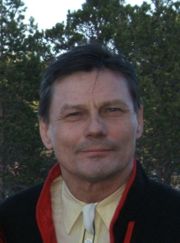
Ole Henrik Magga
Encyclopedia

Sami people
The Sami people, also spelled Sámi, or Saami, are the arctic indigenous people inhabiting Sápmi, which today encompasses parts of far northern Sweden, Norway, Finland, the Kola Peninsula of Russia, and the border area between south and middle Sweden and Norway. The Sámi are Europe’s northernmost...
linguist
Linguistics
Linguistics is the scientific study of human language. Linguistics can be broadly broken into three categories or subfields of study: language form, language meaning, and language in context....
and politician
Politician
A politician, political leader, or political figure is an individual who is involved in influencing public policy and decision making...
from Kautokeino
Kautokeino
or Guovdageaidnu , is a municipality in Finnmark county, Norway. The administrative centre of the municipality is the village of Guovdageaidnu/Kautokeino...
, Norway
Norway
Norway , officially the Kingdom of Norway, is a Nordic unitary constitutional monarchy whose territory comprises the western portion of the Scandinavian Peninsula, Jan Mayen, and the Arctic archipelago of Svalbard and Bouvet Island. Norway has a total area of and a population of about 4.9 million...
.
As a linguist
As a linguist, Ole Henrik Magga is best known for his work on syntaxSyntax
In linguistics, syntax is the study of the principles and rules for constructing phrases and sentences in natural languages....
. His Master's thesis at the University of Oslo
University of Oslo
The University of Oslo , formerly The Royal Frederick University , is the oldest and largest university in Norway, situated in the Norwegian capital of Oslo. The university was founded in 1811 and was modelled after the recently established University of Berlin...
, "Lokative læt-setninger i samisk" (Locative "to be" sentences in Sámi), discussed the structure of existential and habitive sentences, whose structures in many of the Uralic languages
Uralic languages
The Uralic languages constitute a language family of some three dozen languages spoken by approximately 25 million people. The healthiest Uralic languages in terms of the number of native speakers are Hungarian, Finnish, Estonian, Mari and Udmurt...
are similar to each other. His doctoral dissertation in 1986 discussed the structure of Sámi verbal phrases, in particular, the interaction between modal verb
Modal verb
A modal verb is a type of auxiliary verb that is used to indicate modality -- that is, likelihood, ability, permission, and obligation...
s and infinitives.
Magga became professor of Finno-Ugric languages
Finno-Ugric languages
Finno-Ugric , Finno-Ugrian or Fenno-Ugric is a traditional group of languages in the Uralic language family that comprises the Finno-Permic and Ugric language families....
at the University of Oslo
University of Oslo
The University of Oslo , formerly The Royal Frederick University , is the oldest and largest university in Norway, situated in the Norwegian capital of Oslo. The university was founded in 1811 and was modelled after the recently established University of Berlin...
in 1997, after Knut Bergsland
Knut Bergsland
Knut Bergsland was a Norwegian linguist. Working as a professor at the University of Oslo from 1947 to 1981, he did groundbreaking research in Uralic and Eskimo–Aleut languages.-Career:...
, but relinquished his post to work as professor of Sámi Linguistics at the Sámi University College
Sámi University College
Sámi University College was established in 1989 and has about 150 students and 52 faculty, technical and administrative staff. It is one of 25 Norwegian state university colleges and located in Kautokeino....
in Kautokeino. Magga became a member of the Norwegian Academy of Science and Letters
Norwegian Academy of Science and Letters
The Norwegian Academy of Science and Letters is a learned society based in Oslo, Norway.-History:The University of Oslo was established in 1811. The idea of a learned society in Christiania surfaced for the first time in 1841. The city of Throndhjem had no university, but had a learned...
in 1993.
In 2006, Magga was made Commander of the Order of St. Olav.
Political Career
Magga was a delegate to the World Council of Indigenous PeoplesWorld Council of Indigenous Peoples
The World Council of Indigenous Peoples was a formal international body dedicated to having concepts of aboriginal rights accepted on a worldwide scale...
(WCIP) when it was founded in Canada in 1975.
Magga led the Norwegian Sami Association
Norwegian Sami Association
The Norwegian Sami Association , also known as NSR, is the largest Sámi organization in Norway. The association was founded in 1968.-Purpose:The NSR actively runs cultural, social, and informational work through local groups and Sami associations. In total 24 Sami associations are attached to the...
from 1980 to 1985 and was the first president of the Sami Parliament of Norway
Sami Parliament of Norway
The Sami Parliament of Norway is the representative body for people of Sami heritage in Norway. It acts as an institution of cultural autonomy for the indigenous Sami people....
from 1989 to 1997.
From 1992 to 1995, Magga was a member of the Worlds Commission on Culture and Development.
In 2002, Magga became the first chairman of the UN Permanent Forum on Indigenous Issues
United Nations Permanent Forum on Indigenous Issues
The United Nations Permanent Forum on Indigenous Issues is the UN's central coordinating body for matters relating to the concerns and rights of the world's indigenous peoples. "Indigenous person" means native, original, first people and aboriginal. There are more than 370 million indigenous...
.

